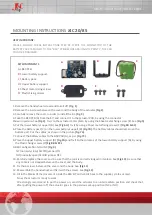
ePWM Submodules
2030
SPNU563A – March 2018
Copyright © 2018, Texas Instruments Incorporated
Enhanced Pulse Width Modulator (ePWM) Module
Although all combinations are supported, not all are typical usage modes.
documents some
classical dead-band configurations. These modes assume that the DBCTL[IN_MODE] is configured such
that EPWMxA In is the source for both falling-edge and rising-edge delay. Enhanced, or non-traditional
modes can be achieved by changing the input signal source. The modes shown in
fall into
the following categories:
•
Mode 1: Bypass both falling-edge delay (FED) and rising-edge delay (RED)
Allows you to fully disable the dead-band submodule from the PWM signal path.
•
Mode 2-5: Classical Dead-Band Polarity Settings:
These represent typical polarity configurations that should address all the active high/low modes
required by available industry power switch gate drivers. The waveforms for these typical cases are
shown in
. Note that to generate equivalent waveforms to
, configure the
action-qualifier submodule to generate the signal as shown for EPWMxA.
•
Mode 6: Bypass rising-edge-delay and Mode 7: Bypass falling-edge-delay
Finally the last two entries in
show combinations where either the falling-edge-delay (FED)
or rising-edge-delay (RED) blocks are bypassed.
Table 35-14. Classical Dead-Band Operating Modes
Mode
Mode Description
DBCTL[POLSEL]
DBCTL[OUT_MODE]
S3
S2
S1
S0
1
EPWMxA and EPWMxB Passed Through (No Delay)
X
X
0
0
2
Active High Complementary (AHC)
1
0
1
1
3
Active Low Complementary (ALC)
0
1
1
1
4
Active High (AH)
0
0
1
1
5
Active Low (AL)
1
1
1
1
6
EPWMxA Out = EPWMxA In (No Delay)
0 or 1
0 or 1
0
1
EPWMxB Out = EPWMxA In with Falling Edge Delay
7
EPWMxA Out = EPWMxA In with Rising Edge Delay
0 or 1
0 or 1
1
0
EPWMxB Out = EPWMxB In with No Delay
















































